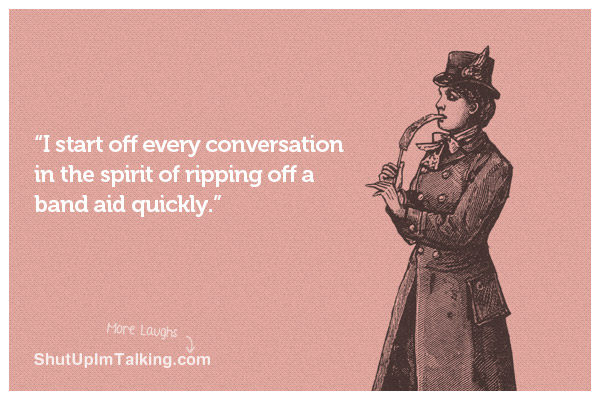How to Perform First Aid on a Conflict.
A wound is an "injury" to the body, "usually involving division of tissue...due to external violence or some mechanical agency rather than disease." "Feelings, sensibilities" and "reputation" can also be wounded when conflict occurs in interpersonal relationships (Source: http://dictionary.reference.com).A conflict occurs between two, or more, parties who "come into disagreement," due to viewpoints that are "contradictory, at variance, or in opposition," to one another. The magnitude of the meaning of this work can be weighted as heavily as "fight, or battle" or as lightly as "incompatibility or interference, as of one idea, desire, event, or activity, with another." (Source: http://dictionary.reference.com)
In trying to understand the meanings of words we have a tendency to reference extremes. For example, what's the image that pops into your head when you read this word?
WOUND
Did you picture a "division of tissue" that was caused during a significant conflict event?
What image appears when you read this word?
CONFLICT
Did you picture a scene of "external violence" where people become physically wounded?
I will make an assumption here that the answer to both "Did you picture..." questions was, "Yes." The purpose is to illustrate the reason why it can be difficult to recognize when relationships have been wounded when the conflict is on the "disagreement in ideas, desires, events, or activities" end of the scale. Most human beings will definitely remember if they've participated in something as significant as an argument, a fight or a battle and the physical or emotional scars they received or inflicted on others. We are forced to deal with smaller-scale conflicts constantly but we don't always recognize the impact the more sublime incidents have on our relationships with others.
When Conflict Wounds Relationships.
 When you find you are at odds with people you need to maintain healthy relationships with in order to be successful, the situation creates discomfort. The discomfort comes from the imagined negative consequences you perceive you'll receive if you fail to resolve the conflict. The fear of the punishment drives you to avoid it so you employ a common tactic and create a distraction from it. Let's say, for example, you change the subject, or defer the current one, so the focus of the discussion will shift from the conflict to something else. You move on and leave the conflict unresolved in order to eliminate the discomfort. In this case, you put a metaphorical bandage on the wound.
When you find you are at odds with people you need to maintain healthy relationships with in order to be successful, the situation creates discomfort. The discomfort comes from the imagined negative consequences you perceive you'll receive if you fail to resolve the conflict. The fear of the punishment drives you to avoid it so you employ a common tactic and create a distraction from it. Let's say, for example, you change the subject, or defer the current one, so the focus of the discussion will shift from the conflict to something else. You move on and leave the conflict unresolved in order to eliminate the discomfort. In this case, you put a metaphorical bandage on the wound.Unresolved Conflicts Become Infected.
Let's say you have a small wound on your hand with a band-aid on it and you started to see symptoms that indicate it's becoming infected. You would rip off the bandage so you could clean it. Taking off the bandage causes pain and discomfort but you do it anyway so you can treat the infection and allow the wound to heal.Think back to the relationship wound you put a metaphorical band-aid on earlier. To ease your discomfort you changed the subject, but you didn't resolve the conflict. Changing the subject didn't make the conflict go away. The conflict remains. The problem with unresolved conflicts is, like untreated wounds, they will become infected. They don't go away, they get worse and things can get really messy!
Don't Let the Pain of Ripping Off the Bandage Keep You From Treating the Wounded Relationship.
The problem with wounded relationships is they don't heal themselves. As conflict festers beneath the bandage you used to distract attention from it, you will experience more and more pain as time goes by. Your attempt to avoid a punishment has only driven you to create a more painful one. The only way to cure your pain is to endure the pain of ripping the bandage off and deal with the conflict directly with the other person. |
| Source: http://shutupimtalking.com/wp-content/uploads/2012/08/02181.jpg |
Failing to deal with conflict directly is like trying to clean an infected wound while it is covered with a bandage. It's ineffective. It doesn't matter how small the wound, the infection is the real relationship killer!
I once worked with a company that was extremely conflict averse. I was hired to help them solve some significant teamwork issues. I observed a few meetings and noticed when employees communicated their disagreement to proposals or statements from others in meetings the president, having the noble intention of wanting to foster a harmonious culture, would stifle the conversation and change the subject. Invariably the unresolved issue would lead to frustration on the part of the dissenter. Deferring the conflict didn't allow them to communicate counter points that had the potential to call attention to problems, suggestions for improvements or intending to point out misalignments.
The forced end to the conversations invariably led to wounded relationships, frustration and confusion about what the priorities in the organization really were. The leader had good intentions but misunderstood that harmony takes practice. If you don't believe that, listen to a 5th grade music band and compare their sound with that of a senior high school band and recognize the difference practice can make. If an organization is never allowed to operate with conflict, it won't learn how to resolve it. The leader missed the opportunity to facilitate open, honest and respectful debate, which is a form of conflict people can function under in a positive manner.
As a leader, can you afford to let conflict infect your organization? Can you afford to let the wounds you've created or have observed in other relationships within your organization fester?
Performing First Aid on a Conflict
To avoid setting the conditions that will allow conflict to fester in a relationship it's best to perform First Aid. A clean and treated wound will heal very quickly. The next time you recognize a disagreement is about to be left unresolved, here's how to perform First Aid:
- Recognize a relationship has been wounded- Think about the potential consequences of hoping it will heal on its own. How much pain will be created if it's left unresolved:
- For you?
- For the relationship?
- For the organization's ability to function efficiently & effectively?
- Treat the open wound- Stop the avoidance tactic. It will be uncomfortable for you but the outcome you want is to preserve the integrity of the relationship. Show the courage needed to bring the conversation back on track and then:
- Evaluate- Ask for clarification.
- Try to Understand the Root Cause- The reason why people put a band-aid on a conflict typically has nothing to do with the difference in points of view that started it. The reason usually stems from to root cause categories:
- Authoritative Power- When someone disagrees with a person who has authoritative power in a situation, they perceive they are in a coercive situation. This is an opportunity to show you're willing to use reason and logic to show you want to use your power legitimately instead of simply imposing your authority. (Important Note- If you've used authoritative power as your predominant method of influencing situations in the past and you're trying to change perceptions so people will work with you instead of for you, remember it will probably take at least six months of consistent, legitimate use of your power to gain their trust. One slip and you're back to day-one. That's the way people work, sport! Take it seriously!).
- Frustration from past coercive situations- When people avoid conflict for this reason, they're trying to prevent themselves from communicating inappropriately in the situation. In other words, they're about to say something they'll regret. Recognize their frustration. It's important! If you can't help them relieve their frustration, it will keep building. Ask them if they'd like to talk off-line. If that means the meeting needs to end right there, so be it. They'll appreciate you giving them the attention they deserve (Important Note- See "Important Note" above and apply the same concept here. Think about it.).
- Shhhhh...Listen... What did you miss? I promise, you missed something, so focus on listening.
- Affirm- Let them know you heard them and the points they're trying to make.
- Confirm- Try to identify the point of conflict and find out if the other person also recognizes it as the root cause of the disagreement. This allows both parties to focus on the real issue instead of feeling like they're battling each other.
- Align- If you've personified the values of COURAGE, PATIENCE, SEEKING and REASON, by following the past five steps, you've set the conditions to become an advocate instead of an adversary. The two conflicting parties now have a common enemy against which they can ally themselves and focus on fighting: The Root Cause of the Conflict.
 |
| Get the win you really want and PRE-ORDER FINDING SUCCESS NOW! |
If conflict already festers in your organization, you won't be able to fix it all overnight. Heal one wound at a time and perform First Aid on the new ones to prevent conflict from infecting your organization to a point where it becomes less effective.
THE GPS THEORY MODEL
|
 ABOUT THE AUTHOR: Tom Eakin is the author of Finding Success and the Success Engineer at BoomLife. LEARN MORE ABOUT TOM...
ABOUT THE AUTHOR: Tom Eakin is the author of Finding Success and the Success Engineer at BoomLife. LEARN MORE ABOUT TOM...
























